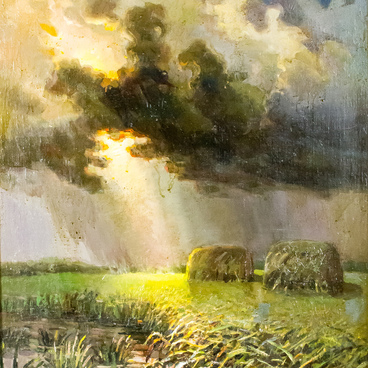The painting by an unknown painter shows a traditional Japanese landscape. In the foreground, the author placed two tall relief trees, most likely pine trees, and in the distance, there are snow-capped mountain peaks. In the center of the painting, the painter depicted a minka, a traditional Japanese house. The figures of two people are seen near it, on the bridge across the stream of a mountain waterfall.
There is a gazebo on the left, near one of the pine trees; three people are heading to this gazebo along the road.
The painting is decorated with a wooden frame with a floral pattern in the form of intertwined branches of a sakura tree. The corners of the frame are bonded with openwork metal plates on the front side. The canvas was painted with thick dense dabs of oil paint, creating the effect of a three-dimensional relief.
The landscape painting was confiscated from the landlady of Tetyushi Uyezd Sazonova in May 1918, during the nationalization of the merchant property, following which the workers and peasants' militia handed over the canvas to the local museum.
Japanese painting was formed under the influence of the art of Ancient China. Japanese people borrowed the system of genres, the ideological foundations of painting, symbolism, and other artistic means from their neighbors.
The Japanese landscape is called “shan shui”, which means “mountains and waters”. Oriental painters did not just depict nature, but put a certain philosophy into their work, created an image of an ideal cosmic order on their canvases. Mountains and water symbolize the opposites that make up the driving force of the Universe. The opposites form the harmony of the universe, and the main task of a painter is to reflect it. Realism, which became the basis of classical Western painting, had no value for the Japanese.
Each object in the painting has a symbolic meaning. For example, a tall evergreen pine tree in both Chinese and Japanese art denotes a straight, noble person who withstands with dignity and fortitude any tests of fate and triumphs over all adversities on the path of self-improvement.
There is a gazebo on the left, near one of the pine trees; three people are heading to this gazebo along the road.
The painting is decorated with a wooden frame with a floral pattern in the form of intertwined branches of a sakura tree. The corners of the frame are bonded with openwork metal plates on the front side. The canvas was painted with thick dense dabs of oil paint, creating the effect of a three-dimensional relief.
The landscape painting was confiscated from the landlady of Tetyushi Uyezd Sazonova in May 1918, during the nationalization of the merchant property, following which the workers and peasants' militia handed over the canvas to the local museum.
Japanese painting was formed under the influence of the art of Ancient China. Japanese people borrowed the system of genres, the ideological foundations of painting, symbolism, and other artistic means from their neighbors.
The Japanese landscape is called “shan shui”, which means “mountains and waters”. Oriental painters did not just depict nature, but put a certain philosophy into their work, created an image of an ideal cosmic order on their canvases. Mountains and water symbolize the opposites that make up the driving force of the Universe. The opposites form the harmony of the universe, and the main task of a painter is to reflect it. Realism, which became the basis of classical Western painting, had no value for the Japanese.
Each object in the painting has a symbolic meaning. For example, a tall evergreen pine tree in both Chinese and Japanese art denotes a straight, noble person who withstands with dignity and fortitude any tests of fate and triumphs over all adversities on the path of self-improvement.


